Accounts Receivable - Customer Payments
Overview
The Customer Payments screens can be used to perform the following tasks:
- Record payments already received from customers
- Apply payments to outstanding invoices (and potentially other unapplied Customer Payments) or charge them directly to transaction accounts
- Edit unposted Customer Payments
- Apply previously unapplied Customer Payment balances to Invoices
- Recognize payment discounts on Invoice payments
- View the details of previously posted Customer Payments
- Unpost Customer Payments
Customer payments can be made directly to a regular bank account where they will be treated as a deposit of the customer payment, or they can be made to an Undeposited Funds bank account and selected later to include in a Deposit.
After posting a Customer Payment, the document can be voided which reverses out the effects of the Customer Payments on Invoices (and potentially other Customer Payments). This has the effect of reinstating the Invoice (and potentially other Customer Payments) as available for inclusion on another payment.
Customer Payments can have one of the following statuses: INUSE, SUBMITTED or POSTED.
Roles
This screen is available to users having any of the following roles: Administrator, AR User or AR Poster.
- Users having the AR User role are authorized to create, edit, view and submit Customer Payments (limited by Organization Access restrictions).
- Users having the AR Poster role are authorization to post and void Customer Payments (limited by Organization Access restrictions). Customer Payments can be posted directly from the Customer Payments List for those entries having a status of SUBMITTED, or individual Customer Payments can be posted directly from the Customer Payment screen using the Post/Next button.
License
This screen is available with the Project Financials family of Unanet licenses.
Topics covered on this help page include:
-
Search (to refine the list of Customer Payments)
-
List (to view, edit, delete, void or post Customer Payments)
-
Add (to add Customer Payments)
-
Lookup Invoice (to identify invoices when adding Customer Payments)
-
Edit
-
-
Summary (to edit Customer Payment summary information)
-
Paid Documents (to edit Customer Payment paid documents)
-
Details (to edit Customer Payment details)
-
Attachments (to add attachments to a Customer Payment)
-
View (to see a view only copy of a Customer Payment)
-
Post (to post Customer Payments)
-
Void (to void a Customer Payment)
-
Unpost (to unpost a Customer Payment)
-
Closed Fiscal Year (adjusting entries when posting/voiding to a closed fiscal year)
-
Apply (to Apply previously unapplied balances to a Customer Payment)
You may also be interested in:
Search
Using the Customer Payment Search screen, you can refine the list of Customer Payments with which you have interest, by supplying search criteria and clicking on the List tab. The default selection criteria is configured to return all INUSE Customer Payments for the current month.

Field Descriptions (click on a link below for additional information):
List
The entries included in the resulting List screen will contain any items matching the supplied search criteria. For those items in the SUBMITTED status, a leading check box is available which can be used to initiate a bulk Post action directly from this screen by clicking the Post button. A number of additional are available to facilitate a variety of activities.
Drill Down Note: You can click on the value in the Balance column to view the Customer Payment Balance Details popup report.

Note that entries associated with Customer Organizations that do not have a specified Remit To Organization Address will be flagged in this listing.
Field Descriptions (click on a link below for additional information):
|
|
-
(To save criteria, add, view, edit, delete, void, apply previously unapplied balances, know attachments exist; or post one to many submitted Customer Payments.)
-
-
-
-
-
-
-
-
-
-
-
-
-
-
-
-
-
-
-
-
-
-
|
Customer Payment - Balance Details Popup
The Customer Payment - Balance Details Popup report will resemble the following:

Add Customer Payment
Clicking on the  link (available on the Customer Payment - Search/List screens), will present you with the Customer Payment - Summary screen where you will supply the summary information for a Customer Payment. Subsequent to providing the summary level information, you will likely want to navigate to the Paid Documents and/or Details options, to indicate to which Invoices a payment is addressing (via Paid Documents screen) and/or directly enter transactions where no Invoice was sent (via Detail screen).
link (available on the Customer Payment - Search/List screens), will present you with the Customer Payment - Summary screen where you will supply the summary information for a Customer Payment. Subsequent to providing the summary level information, you will likely want to navigate to the Paid Documents and/or Details options, to indicate to which Invoices a payment is addressing (via Paid Documents screen) and/or directly enter transactions where no Invoice was sent (via Detail screen).
On this Summary screen, you will enter information regarding the Customer from which you are receiving a payment, the bank account to which the payment will be deposited, the payment amount, the document and post dates, any comments you'd like to associate with the entry and more.
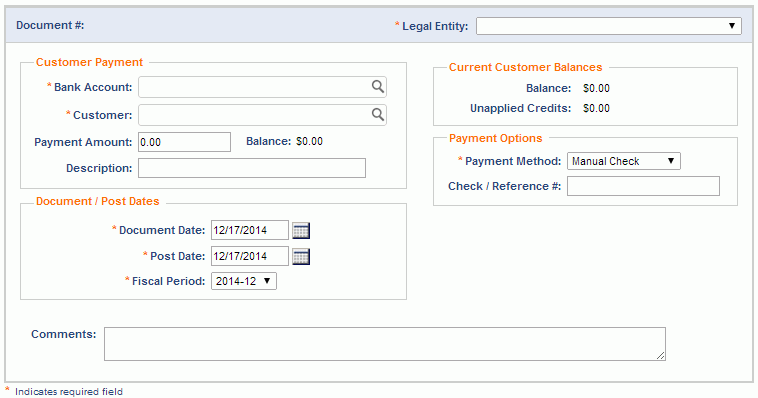
Field Descriptions (click on a link below for additional information):
Lookup Invoices
The Lookup Invoices feature allows you to see multiple invoices of the same customer. Keep in mind that when applying payments, they can only be applied to one customer at a time.
Click on the Lookup Invoices button, and you will find there are 4 convenient ways to search for invoices:
1. Customer - when you search by Customer, this field will support the concept of a comma separated list
2. Project - when you search by Project, this field will also support the concept of a comma separated list
3. Invoice Number - if you remembered the precise Invoice Number, or numbers of multiple invoices (entered separately of course), you can enter them in this field
4. Invoice Amount - if you do a search by Invoice Amount, it must be the exact amount, including exact change
Selecting the invoices will auto-populate some of the cells in the screen below (in this case, three of IBM's invoices were checked off in the boxes on the left side. The amounts added up automatically and appeared in the Payment Amount cell).
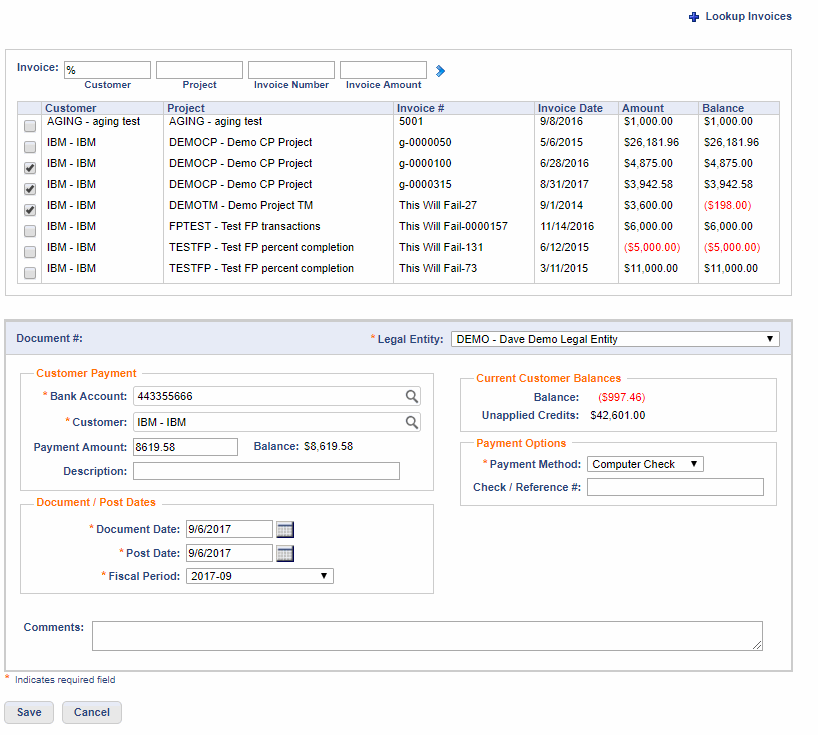
Edit Customer Payment - Summary
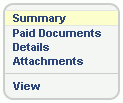
The Edit Customer Payment screen (which you can get to by navigating to the Summary left menu option after clicking the pencil icon from the Customer Payment list screen), is nearly identical to the Customer Payment Add screen. On this screen you can modify most fields with the exception of Legal Entity (which can no longer be modified once any Paid Document or Detail line items have been added to this Customer Payment). This screen also displays the Customer Payment Document # assigned to this Customer Payment.
The Summary menu option will become unavailable once the Customer Payment reaches the POSTED status.
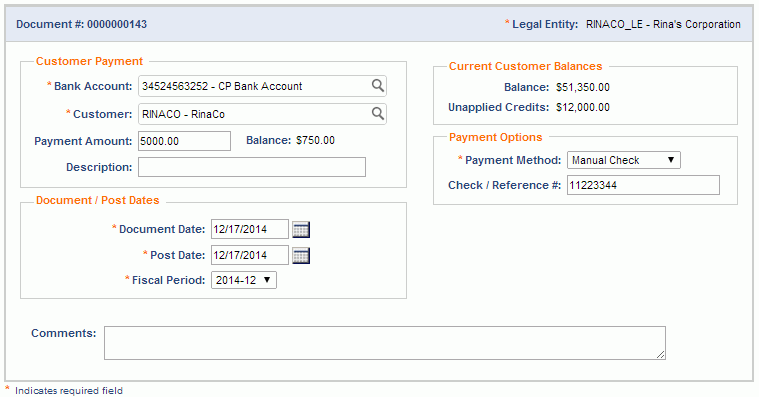
Field Descriptions (click on a link below for additional information):
Edit Customer Payment - Paid Documents
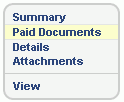
This screen will display a list of previously included and potentially includable documents (ie posted Invoices and/or other posted Customer Payments) which may be associated with the current Customer Payment. From this list you can choose which Invoices this payment will cover and/or which other Customer Payments (having an unapplied amount) this Customer Payment will address.
You can navigate to the Paid Documents screen via the left menu option (once editing a Customer Payment) or directly by clicking the edit pencil icon from the Customer Payment list screen.
The Paid Documents menu option will become unavailable once the Customer Payment reaches the POSTED status.
Header
The information in the 'header' section of the screen will recap the information provided on the document Summary.
Note the values in the Current Customer Balances area will not change as information is entered in this screen until such time that a Save occurs.
Paid Documents Grid
To indicate that a particular Invoice or Customer Payment is to be included in this Customer Payment document, you must click on the check box in the leading column of a desired row (or the check box at the top of that column which will toggle all rows on and off). Once you have checked the leading check box, the Payment and Discount fields will become enabled for entry (see field descriptions below for additional details as to when a field may or may not be enabled). You can choose to use the default suggested Payment and Discount amounts, or provide alternate values. As values are entered, the column totals and Remaining values will be dynamically updated, as will the in the left side of the Header.
This grid may include two types of entries, CI (Customer Invoices) and/or CP (other Customer Payments). These documents will be displayed as follows:
- Documents that have been previously included (and saved) in this Customer Payment will be listed first, and they reflect the actual payment and discount amounts specified when originally included.
- Documents that are potentially includable reflect suggested payment and discount amounts relative to the document's current balance and end date of the fiscal period into which it is being posted.
Potentially Includable documents are:
-
- Invoices and Customer Payments having the same customer and legal entity
- Posted documents having a Post Date less than or equal to this Customer Payment's Fiscal Period End Date
- Documents having a non-zero balance
- Not the original Customer Payment document (if we are applying a previously unapplied balance for that Customer Payment)
- Documents that are currently "included" on some other Customer Payment
Order
Within the previously included and potentially includable entries, documents will be sorted in the following order:
-
- Customer Invoices first,
- Customer Payments second.
Within these groupings, documents are additionally ordered by Document # descending.
Submit/Post Validations
A few noteworthy validations that occur at the time of submittal or posting, include:
- The sum of Payment, Discount and Write Off cannot exceed the Balance on any given Paid Documents row.
- The sum of the amounts applied in the Paid Documents and Details grids are not:
-
- greater than a positive Summary --- Payment Amount
- less than a negative Summary --- Payment Amount
- Customer Payments can be submitted and posted without having any Paid Documents or Details grid entries.
For a more complete listing of validations, see the button description.

Field Descriptions (click on a link below for additional information):
Buttons (click on a link below for additional information):
Edit Customer Payment - Details
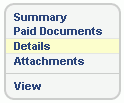
This screen is available to enter the detail line items making up a Customer Payment (which you can get to by navigating to the Details left menu option after clicking the pencil icon from the Customer Payment list screen). The entries on this screen represent transactions where no Invoice has been entered into Unanet and the accounting distribution must be entered along with the payment.
The Detail menu option will become unavailable once the Customer Payment reaches the POSTED status.
Header
The information in the 'header' section of the screen will recap the information provided on the document Summary.
Note the values in the Current Customer Balances area will not change as information is entered in this screen until such time that a Save occurs.
Details Grid
This section of the Customer Payment Details screen is where you will be entering the individual line items that make up the Customer Payment.
For those Accounts that have been designated as requiring Project information (configured on the Admin >> Setup >> Accounts screen with the Require Project indicator checked), you can also provide additional 'reference' information (such as the project, task, project type, expense type, and possibly person).
Customer Payments can be submitted and posted without having any Paid Documents or Details grid entries.

Field Descriptions (click on a link below for additional information):
Buttons (click on a link below for additional information):
Customer Payment Attachments
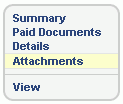
This screen is available to attach one or more documents to a Customer Payment (which you can get to by navigating to the Attachments left menu option after clicking the pencil icon from the Customer Payment list screen).
The Attachments menu option will become unavailable once the Customer Payment reaches the POSTED status.
Note: The Unanet Administrator may want to suggest guidelines with regards to what types of files may be acceptable to be used as Customer Payment attachments, particularly in the case where any documents are being scanned and saved as a graphics file. Certain graphics file formats are known to result in much larger files sizes than others and you may want to consider suggesting a specific file type to help control the amount of data being stored in your database. Generally speaking, jpg and gif files tend to be much smaller than tif and png file formats.
To assist with the management of allowable attachment types and size, the administrator can use the following three properties: Maximum Size Allowed for each attachment (unanet.attachment.max_size), File Extensions that are Not Allowed (unanet.attachment.invalid_file_extensions) and File Extensions that are allowed (unanet.attachment.valid_file_extensions).

Using this screen, the user can add, remove or view an attachment. The Save button will save the changes to the attachment screen and return the user to the Customer Payment Details screen. The Cancel button will also navigate the user to the Customer Payment Details screen but without saving any changes. Clicking on the paper clip icon will launch a new window and attempt to display the attachment (assuming your local PC knows what application to execute to view the specific file type).
Field Descriptions (click on a link below for additional information):
Where can attachments be seen?
The Customer Payment >> List screen will contain a paperclip ( ) icon to indicate attachments exist on a particular Customer Payment. Clicking on the icon will navigate the user to the Customer Payment >> View screen with the Attachment section expanded.
) icon to indicate attachments exist on a particular Customer Payment. Clicking on the icon will navigate the user to the Customer Payment >> View screen with the Attachment section expanded.
When viewing a Customer Payment that has attachments, the list of attachments will appear in an expandable table under the displayed Customer Payment details as in the example below. You can click on the paper clip icon ( ) and view the attached document (assuming you have the necessary local software installed to view the particular file type). This section will only appear if attachments exist.
) and view the attached document (assuming you have the necessary local software installed to view the particular file type). This section will only appear if attachments exist.

View Customer Payment
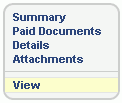
This screen is available to view a read-only version of the Customer Payment document (which you can get to by navigating to the View left menu option after clicking the pencil icon from the Customer Payment list screen or by clicking on the eye glasses icon on the Customer Payment >> List).
Once the Customer Payment reaches the POSTED status, this will be the only available menu option.
An Edit button will appear at the bottom of this screen if all of the following conditions are met:
- The user viewing the Customer Payment has access to this Customer Payment's Legal Entity
- The status is anything other than Posted
If the Customer Payment had been in a status of SUBMITTED, then clicking on the Edit button will return the status to INUSE.
Post Customer Payment
Roles
This screen is available to users having any of the following roles: Administrator or AR Poster. Note that AR Posters are limited to posting Customer Payments for the Legal Entities they have access to via Financial Organization Access.
Customer Payments can be posted from two screens:
- Individual Customer Payment Post -- When editing the Paid Documents or Details grid for a Customer Payment, the current Customer Payment can be posted by clicking the Post/Next button. Customer Payments in the INUSE or SUBMITTED status may be posted from this screen.
- Bulk Customer Payment Post -- When listing one or many Customer Payments on the Customer Payment >> List screen, the user can check one or many Customer Payments and click on the Post button to invoke a post for many Customer Payments. Only those Customer Payments in the SUBMITTED status can be included in a bulk post.
The posting process includes the following (not necessarily generated in this order):
- Create General Ledger Entries -- GL entries are only generated when posting to the General Ledger (ie Post to General Ledger (unanet.financials.post_to_gl) property enabled and the Post to General Ledger Effective Date (unanet.financials.post_to_gl.eff_date) <= document post date).
Attributes for the general ledger entry will include (for the individual entries, those attributes that are different than the general entry will be noted):
- Feature - CUSTOMER PAYMENT
- Document Number - Current document's document number
- Post Date - Current document's post date
- Fiscal Month - Fiscal month containing post date of current document
- Account - Described below
- Organization - Described below
- Project - Optional, relevant to Detail grid entries.
- Description - Current document's description (exception - Detail entry uses detail documents description)
- Transaction Date - Current document's document date (exception - Detail entry uses detail documents document date)
-
- Summary -- Create general ledger records for values from the Summary record.
-
- Balance Amount
Entry depends on whether this is an Application Document or a Regular Customer Payment
-
- Application Document
-
- Application documents will not have their own Balance, that is, they are merely the next "installment" against the original Customer Payment.
- The GL amount to be recorded is the impact of this application on the remaining balance of the original Customer Payment.
- The amount recorded is calculated as the sum of the Paid Document Payment Amounts + Detail Amounts.
- The Org and Account used will be taken from the Customer Payment unapplied balance record.
- A positive amount will be recorded as a Debit amount.
- A negative amount will be recorded as a Credit amount.
- Regular Customer Payment
-
- The amount recorded is calculated as the difference between the Summary Payment Amount and the sum of the Paid Document Payment Amounts + Detail Amounts.
- The Org and Account used will be taken from the Customer Payment unapplied balance record.
- A positive amount will be recorded as a Credit amount.
- A negative amount will be recorded as a Debit amount.
- Payment Amount entry
-
- The GL amount recorded will be the value of the Payment Amount field on the Summary record, and will be posted whether or not it is zero.
- The Org and Account used will be taken from the Bank Account associated with the Customer Payment document.
- A positive amount will be recorded as a Debit amount.
- A negative amount will be recorded as a Credit amount.
- Paid Documents -- Create general ledger records for the non-zero rows in the Paid Documents grid.
-
- Customer Invoice (CI) rows:
-
- Amount
-
- The GL amount recorded will be the sum of the Payment Amount, Discount Amount and Write Off Amounts.
- The Org and Account used will be taken directly from the invoice referenced in the Paid Document record.
-
- Should the invoice have been completed prior to the use of Financial Orgs having been enabled, it is possible the invoice will not have a posting org value. In such a case, the Org and Account used will be derived from the Posting Group values (for the invoice's Lead Project, or the system default Posting Group when no specific posting group has been designated for a project) for the BILLED category based on the Legal Entity of the document and the invoice's lead project.
- A positive amount will be recorded as a Credit amount.
- A negative amount will be recorded as a Debit amount.
- Discount
-
- The GL amount recorded will be the value of the Discount amount.
- The Org and Account used will be derived from the Posting Group values (for the invoice's Lead Project, or the system default Posting Group when no specific posting group designated for a project) for the AR DISCOUNT TAKEN category based on the Legal Entity of the document and the invoice's lead project.
- A positive amount will be recorded as a Debit amount.
- A negative amount will be recorded as a Credit amount.
- Write Off
-
- The GL amount recorded will be the value of the Write Off amount.
- The Org and Account used will be derived from the Posting Group values (for the invoice's Lead Project, or the system default Posting Group when no specific posting group designated for a project) for the AR SMALL BALANCE WRITE-OFF category based on the Legal Entity of the document and the invoice's lead project.
- A positive amount will be recorded as a Debit amount.
- A negative amount will be recorded as a Credit amount.
- Customer Payment (CP) rows:
-
- Amount
-
- The GL amount recorded will be the value of the Payment amount.
- The Org and Account used will be taken from the Customer Payment unapplied balance record that was created when this Paid Document Customer Payment was originally posted and we detected that it had an unapplied balance (which we are now attempting to "use up").
- A positive amount will be recorded as a Credit amount.
- A negative amount will be recorded as a Debit amount.
- Detail -- Create general ledger records for the non-zero rows in the Detail grid.
-
- The GL amount recorded will be the value of the Amount field.
- The Org and Account used will be taken directly from the Detail record.
- A positive amount will be recorded as a Credit amount.
- A negative amount will be recorded as a Debit amount.
- Create Unapplied Balance Entries - Unapplied balance entries are only generated when processing Customer Payment Application Documents or regular Customer Payments having a non-zero Balance amount. These entries are used to allow the system to associate activity against customer payments that have or had outstanding balances.
- Application Document
-
- The Org and Account used will be taken from the unapplied balance record that was created when the original Customer Payment was posted.
- Regular Customer Payment
-
- The Org and Account used will be derived from the Posting Group values for the AR UNAPPLIED PAYMENT ACCOUNT category based on the Legal Entity of the customer payment.
- Create Project Expense Entries -- Project expense entries are only generated when the document has non-zero Detail rows that include project info. For each of those rows, we will create project expense records (to be available for subsequent Billing Post & Invoicing activities).
- The expense amount recorded will be based on the Detail's Amount as follows:
-
- A positive amount will be recorded as a negative expense amount.
- A negative amount will be recorded as a positive expense amount.
- Alternatively explained, the project expense entry is based on the associated GL entry calculated as debit - credit.
Validations
While you can save a financial document violating certain rules, you will not be permitted to submit or post the document until they are resolved. If any of the validations fail for any row on the document, the entire document cannot be posted.
- Standard financial document validations
-
- Only System Administrators can post into closed Fiscal Periods / Years
- When posting a recurring document and the document is not the last in the series, the post process will attempt to automatically create the next occurrence into the next fiscal period. The post will be prevented if the next fiscal period does not exist.
- Standard financial document validations for Summary level information
- Legal Entity must be a financial organization
- Legal Entity must still be defined as Legal Entity at time of posting
- Standard financial document validations for each Detail row
- The row's Account must be active
- Transaction Entry must be allowed for the Account
- Document's Post Date must be within the allowed transaction date range for Account
- Account must still be valid for the Organization
- Organization must be active
- Organization must belong to this document's Legal Entity
- Transaction entry must be allowed for Organization
- Document's Post Date must be within the allowed transaction date range for Organization
- Project must be provided if Account requires project
- Project must not be provided if Account does not require project
- Project provided must be active
- Project's Owning Organization must belong to this document's Legal Entity
- Task must be provided if project is defined as "requires tasks for expense reporting"
- Task provided must be active
- When Project provided, Project Type must be provided
- When Project provided, Expense Type must be provided
- Expense Type must be valid for the Account
- Expense Type must be valid for the project
- Additional Customer Payment specific validations:
-
-
-
-
- Additional Submit/Post time validations:
-
- The sum of the amounts applied in the Paid Documents and Details grid are not:
-
- greater than a positive Summary --- Payment Amount
- less than a negative Summary --- Payment Amount
Void Customer Payment
Roles
This icon is available to users having any of the following roles: Administrator and AR Poster.
Clicking on the Void icon ( ) in the Customer Payment List will allow you to void a POSTED Customer Payment (generating a negating / voiding Customer Payment, reversing GL and Project Expense entries, etc). This action does not delete any entries nor will it recalculate any values, but rather creates a set of reversing entries based on the original transactions. This is true even if attributes referenced in the original documents have subsequently been made inactive, the voided transaction will continue to use those attributes to reflect the reversing values.
) in the Customer Payment List will allow you to void a POSTED Customer Payment (generating a negating / voiding Customer Payment, reversing GL and Project Expense entries, etc). This action does not delete any entries nor will it recalculate any values, but rather creates a set of reversing entries based on the original transactions. This is true even if attributes referenced in the original documents have subsequently been made inactive, the voided transaction will continue to use those attributes to reflect the reversing values.
Note: If the Allow Users to Unpost Customer Payments (unanet.financials.allow_customer_payment_unpost) property has been enabled, and the current user has the Administrator role, clicking the Void icon will present a sub-menu containing two choices: Void Customer Payment or Unpost Customer Payment.

When this property is not enabled, clicking the void item will immediately take the user to the Void screen.
The posting process includes the following:
- Create a "Voiding" Customer Payment -- Clone the document being voided. The voiding document will be identical to the original document with the following differences:
-
- All amounts (i.e. Summary, Paid Document, and all Detail grid row amounts) are reversed (ie have opposite signs) on the clone.
- Document Date will reflect the Void Date supplied on this screen (Detail line item dates will be the same as they were on the original document).
- Description will reflect the value supplied on this screen.
- Post Date and Fiscal Period will reflect the values supplied on this screen.
- The Transaction Date for the reversing document's details should be the original line item date.
- Create "Reversing" General Ledger Entries -- Reversing GL entries are only generated when posting to the General Ledger (ie Post to General Ledger (unanet.financials.post_to_gl) property enabled and the Post to General Ledger Effective Date (unanet.financials.post_to_gl.eff_date) <= document post date):
- GL transactions will be generated regardless of whether the posting of the original document resulted in GL transactions.
- Summary -- Create reversing general ledger records for values from the Summary record.
-
- Balance Amount
Entry depends on whether we are voiding an Application Document or a Regular Customer Payment
-
- Application Document
-
- The amount recorded is the negated amount from the voided document (calculated as the sum of the Paid Document Payment Amounts + Detail Amounts).
- The Org and Account used will be taken from the related unapplied balance record.
- A positive amount will be recorded as a Debit amount.
- A negative amount will be recorded as a Credit amount.
- Regular Customer Payment
-
- The amount recorded is the negated amount from the voided document "Balance" field (calculated as the difference between the sum of the Paid Document Payment Amounts + Detail Amounts).
- The Org and Account used will be taken from the related unapplied balance record.
- A positive amount will be recorded as a Credit amount.
- A negative amount will be recorded as a Debit amount.
- Payment Amount
-
- The amount recorded will be the negated value of the Payment Amount field from the voided document, and will be posted whether or not it is zero.
- The Org and Account used will be taken from the GL transaction generated when the original document was posted.
- A positive amount will be recorded as a Debit amount.
- A negative amount will be recorded as a Credit amount.
- Paid Documents -- Create reversing general ledger records for the non-zero rows in the Paid Documents grid.
-
- Customer Invoice (CI) rows:
-
- Amount
-
- The GL amount recorded will be the sum of the Payment Amount, Discount Amount and Write Off Amounts negated.
- The Org and Account used will be taken from the GL transaction generated when the original document was posted.
-
- If GL posting was not required at the time the original Customer Payment was generated, the Org and Account used will be taken from the Customer Invoice.
- Should the invoice have been completed prior to the use of Financial Orgs having been enabled, it is possible the invoice will not have a posting org value. In such a case, the Org and Account used will be derived from the Posting Group values (for the invoice's Lead Project, or the system default Posting Group when no specific posting group has been designated for a project) for the "Billed" category based on the Legal Entity of the document and the invoice's lead project.
- A positive amount will be recorded as a Credit amount.
- A negative amount will be recorded as a Debit amount.
- Discount
-
- The GL amount recorded will be the value of the Discount amount negated.
- The Org and Account used will be taken from the corresponding Discount GL transaction generated when the original document was posted.
-
- If GL posting was not required at the time the original Customer Payment was generated, the Org and Account used will be derived from the Posting Group values (for the invoice's Lead Project, or the system default Posting Group when no specific posting group designated for a project) for the "AR Discount Taken" category based on the Legal Entity of the document and the invoice's lead project.
- A positive amount will be recorded as a Debit amount.
- A negative amount will be recorded as a Credit amount.
- Write Off
-
- The GL amount recorded will be the value of the Write Off amount negated.
- The Org and Account used will be taken from the corresponding Write Off GL transaction generated when the original document was posted.
-
- If GL posting was not required at the time the original Customer Payment was generated, the Org and Account used will be derived from the Posting Group values (for the invoice's Lead Project, or the system default Posting Group when no specific posting group designated for a project) for the "AR Small Balance Write-Off" category based on the Legal Entity of the document and the invoice's lead project.
- A positive amount will be recorded as a Debit amount.
- A negative amount will be recorded as a Credit amount.
- Customer Payment (CP) rows:
-
- Amount
-
- The GL amount recorded will be the value of the Payment amount negated.
- The Org and Account used will be taken from the corresponding unapplied balance record generated when the original document was posted.
-
- If GL posting was not required at the time the original Customer Payment was generated, the Org and Account used will be taken from the Customer Payment unapplied balance entry.
- A positive amount will be recorded as a Credit amount.
- A negative amount will be recorded as a Debit amount.
- Detail -- Create reversing general ledger records for the non-zero rows in the Detail grid.
-
- The GL amount recorded will be the negated value of the Amount field from the document being voided.
- The Org and Account used will be taken from the GL transaction generated when the original document was posted.
- A positive amount will be recorded as a Credit amount.
- A negative amount will be recorded as a Debit amount.
- Create Unapplied Balance Entries - Reversing Unapplied balance entries are only generated when voiding Customer Payment Application Documents or Regular Customer Payments having a non-zero Balance amount.
- Whether the document being voided is an Application Document or a Regular Customer Payment, the Org and Account used will be taken from the unapplied balance record that was created when the document being voided was posted.
- Create "Reversing" Project Expense Entries -- Reversing project expense entries are only generated when the document being voided has non-zero Detail rows that include project info. The void process will create reversing project expense transactions that differ form the original transaction only in the sign of the amounts.
- Void Associated Application Documents -- If the Customer Payment being voided has Application Documents applied to it, each of those that have not already been voided will also be voided (ie each sent through the void process described above).
Validations
- Once you void a document, you cannot 'undo' the void.
- Only POSTED entries can be voided (ie INUSE and SUBMITTED items can be further modified, thus no need to void them).
- You can only void an 'original' document that has not previously been voided.
- You cannot void a voiding document.
- Voiding a document will not void any of the included Paid Documents (Payments or Invoices) but simply void the relationship with the voided customer payment.
To void a Customer Payment, you will need to supply values for the following fields and click on the Void button.
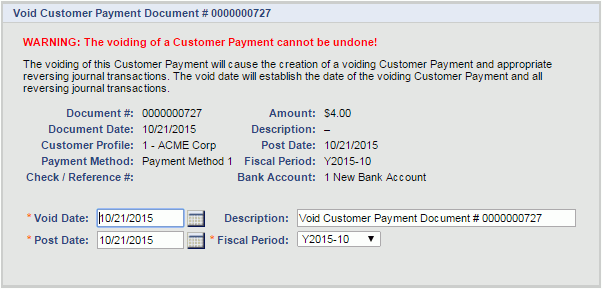
Field Descriptions (click on a link below for additional information):
Unpost Customer Payment
Unposting a previously posted Customer Payment will permanently erase any evidence of that particular post. When running an Unpost, there is no audit trail showing that the original post occurred nor will there be any audit trail that an unpost occurred. In brief, this process will delete journal transactions, general ledger entries (if created) and unmark the originating transactions making them available to participate in another post process.
Roles
This feature is available to users having any of the following roles: Administrator
Note: this feature will only be available if the Allow Users to Unpost Customer Payments (unanet.financials.allow_customer_payment_unpost) property has been enabled. While AR Posters have access to this screen and can click on the Void icon, only users having the Administrator role will see the option related to Unposting.
When enabled, clicking on the Void icon ( ) in the Customer Payment List will present a sub-menu containing two choices: Void Customer Payment or Unpost Customer Payment.
) in the Customer Payment List will present a sub-menu containing two choices: Void Customer Payment or Unpost Customer Payment.

The ability to Unpost is allowed under the following conditions:
- Customer Payment has been posted
- Customer Payment is not a "voiding" document (but can be a "voided" document)
- Customer Payment has been posted to an Open Fiscal Period (that is, you cannot unpost a Customer Payment from a Closed Fiscal Period).
- Customer Payment has not been included in a Deposit document having any status
- Customer Payment does not have any "Application" documents associated with it
Closed Fiscal Years
Posting to Closed Fiscal Year
When posting to or voiding a document from a closed fiscal year, and the document contains details for accounts having account types REVENUE and EXPENSE, where the credits and debits do not cancel each other out (ie. the delta between the revenues and expenses is not = 0), this process will additionally need to generate an adjustment to the previously recorded RETAINED EARNINGS account for the closed year.
Note the adjustment will be generated regardless of the existence of the RETAINED EARNINGS account for the year being adjusted.
The adjusting transaction will have the following attributes:
- Feature - GL Closing
- Document Number - Document number of the document that caused the adjustment
- Post Date - The last day of the fiscal year being adjusted
- Fiscal Month - Fiscal month containing post date of the adjusting document
- Reference - Posting feature of the document that caused the adjustment
- Account - Derived based on the RETAINED EARNINGS category entry in the System Default Posting Group
- Organization - Derived based on the RETAINED EARNINGS account category entry in the System Default Posting Group
- Description - Fiscal Year {adjusted fiscal year value} Closing Entry
- Transaction Date - The last day of the fiscal year being adjusted
- Credit & Debit - As calculated based on the delta between the revenues and expenses included in the document that caused the adjustment. Positive delta should be recorded as a credit, and negative amount as a debit.
Apply Previously Unapplied Balances
Posted Customer Payments that have unapplied balances, will appear in the Customer Payment list with the  (Apply Previously Un-Applied Balance) icon. This icon will only be available on posted Customer Payments having a Balance not equal to zero. This icon will only appear on original Customer Payment documents, that is, you cannot create an application document on top of another application document.
(Apply Previously Un-Applied Balance) icon. This icon will only be available on posted Customer Payments having a Balance not equal to zero. This icon will only appear on original Customer Payment documents, that is, you cannot create an application document on top of another application document.
Clicking on this icon will create an "application document", which is another Customer Payment document that can be used to designate how all or a portion of an unapplied balance should be handled. You will be placed on the Paid Documents screen in the newly created Customer Payment. This new document will have the following fields automatically populated with the values from the original document, and they are un-modifiable (ie read-only values):
- Legal Entity
- Bank Account
- Customer
- Payment Amount
- Description
- Document Date
- Payment Method
- Check/Reference #
- Orig Payment #
The Post Date and Fiscal Period will default to the values from the original document if the Fiscal Period is still open, otherwise, they will default to today’s date and the fiscal period associated with today’s date, respectively. The user can optionally change either of these two values to other valid values.
Once created, you will submit and post the application document just as you would any other Customer Payment.




![]() link (available on the Customer Payment - Search/List screens), will present you with the Customer Payment - Summary screen where you will supply the summary information for a Customer Payment. Subsequent to providing the summary level information, you will likely want to navigate to the Paid Documents and/or Details options, to indicate to which Invoices a payment is addressing (via Paid Documents screen) and/or directly enter transactions where no Invoice was sent (via Detail screen).
link (available on the Customer Payment - Search/List screens), will present you with the Customer Payment - Summary screen where you will supply the summary information for a Customer Payment. Subsequent to providing the summary level information, you will likely want to navigate to the Paid Documents and/or Details options, to indicate to which Invoices a payment is addressing (via Paid Documents screen) and/or directly enter transactions where no Invoice was sent (via Detail screen). 









![]() ) icon to indicate attachments exist on a particular Customer Payment. Clicking on the icon will navigate the user to the Customer Payment >> View screen with the Attachment section expanded.
) icon to indicate attachments exist on a particular Customer Payment. Clicking on the icon will navigate the user to the Customer Payment >> View screen with the Attachment section expanded.![]() ) and view the attached document (assuming you have the necessary local software installed to view the particular file type). This section will only appear if attachments exist.
) and view the attached document (assuming you have the necessary local software installed to view the particular file type). This section will only appear if attachments exist.

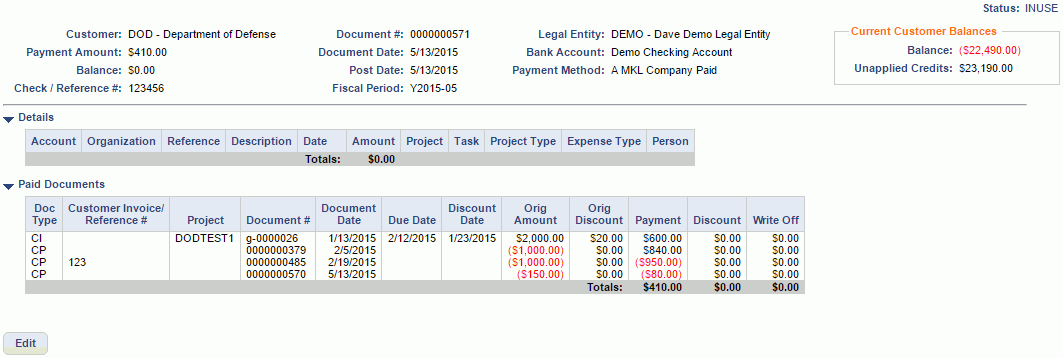
 ) in the Customer Payment List will allow you to void a POSTED Customer Payment (generating a negating / voiding Customer Payment, reversing GL and Project Expense entries, etc). This action does not delete any entries nor will it recalculate any values, but rather creates a set of reversing entries based on the original transactions. This is true even if attributes referenced in the original documents have subsequently been made inactive, the voided transaction will continue to use those attributes to reflect the reversing values.
) in the Customer Payment List will allow you to void a POSTED Customer Payment (generating a negating / voiding Customer Payment, reversing GL and Project Expense entries, etc). This action does not delete any entries nor will it recalculate any values, but rather creates a set of reversing entries based on the original transactions. This is true even if attributes referenced in the original documents have subsequently been made inactive, the voided transaction will continue to use those attributes to reflect the reversing values.

 ) in the Customer Payment List will present a sub-menu containing two choices: Void Customer Payment or Unpost Customer Payment.
) in the Customer Payment List will present a sub-menu containing two choices: Void Customer Payment or Unpost Customer Payment. 
 (Apply Previously Un-Applied Balance) icon. This icon will only be available on posted Customer Payments having a Balance not equal to zero. This icon will only appear on original Customer Payment documents, that is, you cannot create an application document on top of another application document.
(Apply Previously Un-Applied Balance) icon. This icon will only be available on posted Customer Payments having a Balance not equal to zero. This icon will only appear on original Customer Payment documents, that is, you cannot create an application document on top of another application document.